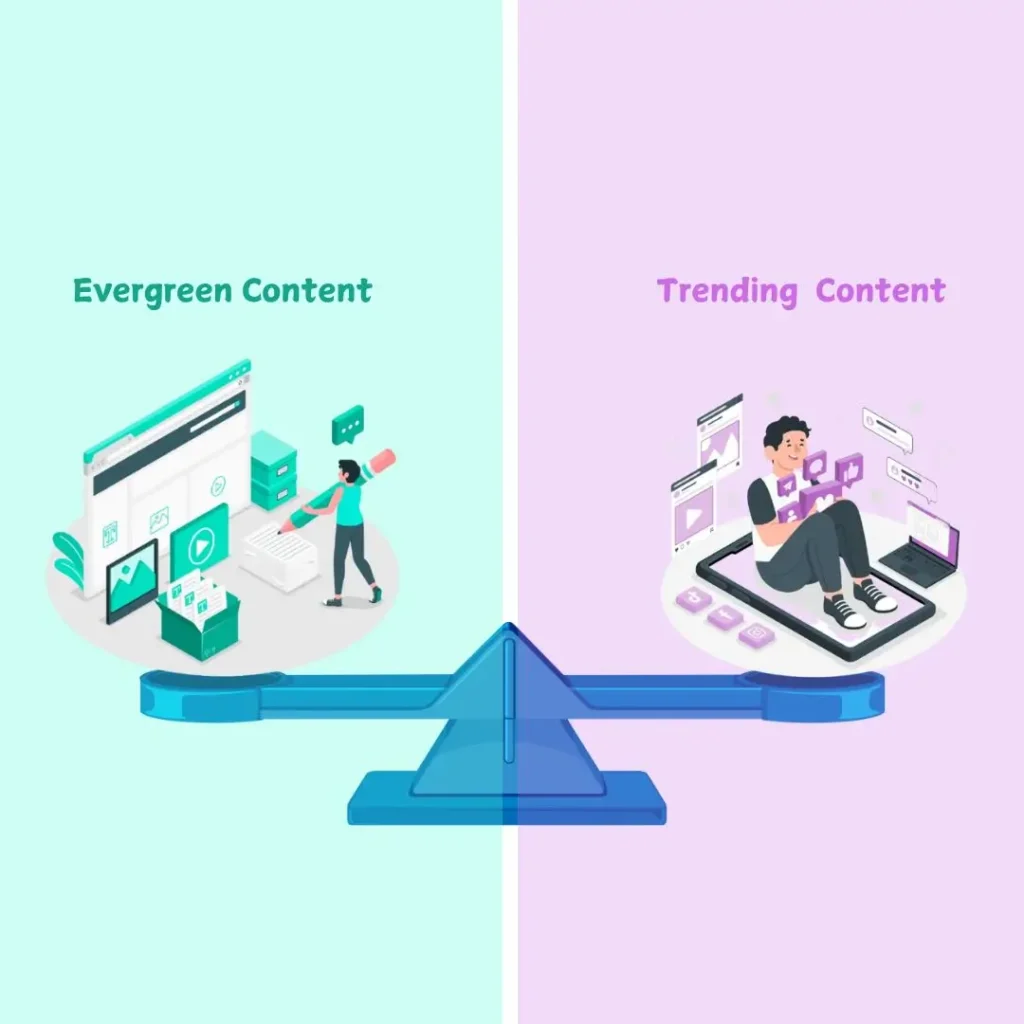
Ever felt overwhelmed by inconsistent content posting? You’re not alone! Managing a website’s content can get chaotic without a structured plan. A content calendar for websites keeps your content strategy organized, ensuring timely posts and improved audience engagement. Without a clear schedule, ideas get lost, deadlines slip, and consistency suffers.
A well-planned calendar not only streamlines content planning but also enhances a blogging schedule, allowing teams to collaborate efficiently.
Now, let’s dive into how you can build one effectively!
What is Content Marketing for Websites?

Content marketing for websites involves crafting valuable, relevant, and engaging content tailored to attract, inform, and convert visitors. It extends beyond blog writing to include videos, case studies, whitepapers, infographics, and social media updates, all designed to enhance audience engagement. A well-structured content strategy helps businesses maintain a strong online presence by delivering the right message to the right audience at the right time. For example, an E-commerce brand selling skincare products might publish detailed skincare guides, product comparisons, and customer success stories to help users make informed decisions, ultimately leading to increased sales.
Why is Content Marketing for Websites Beneficial?
A well-planned content marketing approach offers numerous benefits, including:
- Builds Trust & Credibility – Consistently delivering valuable content positions your brand as an industry authority. An E-commerce brand that publishes in-depth product guides builds consumer confidence.
- Boosts Website Traffic Through Organic Search – A structured blogging schedule ensures fresh, SEO-optimized content, helping search engines index your site more frequently. For instance, an online fashion store posting “seasonal style trends” attracts organic visitors looking for fashion advice.
- Enhances Brand Awareness & Authority – A brand that shares expert insights through blog posts, guest articles, and educational resources naturally becomes a trusted industry voice.
- Improves Lead Generation & Conversion Rates – Gated content like exclusive style guides or discount-based email sign-ups encourage users to engage further, turning visitors into customers.
Who Should Use Content Marketing for Websites?
Many industries benefit from a structured content strategy, including:
- eCommerce – Online stores use product descriptions, customer reviews, and blog posts to educate customers and drive conversions.
- SaaS (Software as a Service) – Software companies rely on tutorials, FAQs, and whitepapers to help users understand their tools and encourage sign-ups.
- Education – Schools, universities, and e-learning platforms use content planning to provide course materials, success stories, and industry insights.
- Healthcare – Hospitals and clinics publish health guides, FAQs, and case studies to inform and engage their patients.
- Finance – Banks and financial advisors leverage blogs and newsletters to explain market trends and investment strategies.
For example, an E-commerce brand selling organic food products can use content marketing to share healthy recipes, diet plans, and customer testimonials, increasing engagement and trust.
How a Content Calendar for Websites Supports Content Marketing

A content calendar for websites acts as a roadmap for content planning, ensuring consistency and alignment with business goals. It helps teams manage content efficiently across multiple platforms, including blogs, social media, and newsletters.
- Organized Workflow – Planning topics, deadlines, and publishing schedules prevents last-minute scrambling. A blogging schedule that outlines product launch announcements and seasonal promotions ensures a steady flow of content.
- Better Resource Allocation – Assigning tasks to writers, designers, and social media managers ensures a smoother execution of campaigns.
- Data-Driven Strategy – Reviewing past content performance helps refine future strategies, ensuring better engagement and SEO results.
For instance, an E-commerce brand selling fitness gear can use a content calendar for websites to schedule blog posts around fitness trends, product launches, and influencer collaborations, ensuring their content remains relevant and timely.
Key Elements of an Effective Content Calendar for Websites
To optimize your content planning, your content calendar for websites should include:
- Topics & Keywords – Plan your blogging schedule around trending topics and SEO-friendly keywords.
- Publishing Dates – Maintain a consistent posting schedule to engage readers.
- Content Format – Define whether it’s a blog post, video, infographic, or social media content.
- Assigned Authors – Allocate content creation tasks effectively.
- Distribution Channels – Plan where to publish (website, social media, newsletters, etc.).
Step-by-Step Guide to Building a Content Calendar for Websites
A content calendar for websites helps businesses streamline their content strategy and maintain consistency across blogs, social media, and other platforms. Here’s how to build an effective calendar that supports long-term content planning and improves engagement.
1. Choose the Right Content Calendar Tool
Using the right tool simplifies content planning and ensures all team members stay aligned. Several tools are available, each catering to different needs.
| Tool | Free/Paid | Usability | Learning Curve | Best For | Other Benefits |
| Trello | Free + Paid | Visual drag-and-drop | Easy | Small teams & freelancers | Integrates with Slack & Google Drive |
| Asana | Free + Paid | Task-based | Moderate | Mid-sized teams | Workflow automation & deadline tracking |
| Notion | Free + Paid | Customizable database | Moderate | Content teams | Flexible formatting & knowledge storage |
| CoSchedule | Paid | Editorial calendar | Easy | Marketing agencies | Built-in social media scheduler |
| Google Sheets | Free | Manual entry | Easy | Beginners | Shareable & customizable |
For instance, if an E-commerce brand is launching a seasonal collection, Trello can help them visually plan blog posts, product launch announcements, and influencer collaborations in one place.
2. Define Your Content Goals
Before filling the content calendar for websites, outline clear objectives:
- Increase organic traffic through a structured blogging schedule.
- Improve customer engagement via informative guides.
- Drive conversions with well-timed promotional content.
For example, an E-commerce brand selling home décor might aim to boost organic traffic by posting seasonal interior design trends before peak shopping seasons.
3. Outline Content Types & Formats
A content strategy should include a mix of formats to engage different audience segments:
- Blog Posts: Informational content like “How to Style Your Living Room with Minimalist Décor.”
- Videos: Product demonstrations or “Behind-the-Scenes” of product manufacturing.
- Infographics: Quick visual guides on choosing furniture based on space constraints.
- Email Newsletters: Personalized recommendations based on previous purchases.
- Social Media Posts: Short, engaging content that complements blogs and email campaigns.
For instance, an E-commerce brand launching a new furniture line can create:
- A blog post on “5 Space-Saving Sofas for Small Apartments.”
- A YouTube video showing sofa transformation options.
- An infographic comparing sofa materials and durability.
4. Identify Publishing Frequency & Best Timing
Determine how often content will be published based on audience behavior and platform algorithms.
- Blogging Schedule: Weekly or bi-weekly for consistent engagement.
- Social Media: Daily updates, stories, and posts to maintain visibility.
- Emails: Monthly newsletters with seasonal discounts or new arrivals.
For example, an E-commerce brand might schedule a holiday gift guide blog post in early November to capture holiday shoppers before peak sales days.
5. Plan & Organize Topics in Advance
Create a structured content planning document outlining topics for the next few months.
Example for an E-commerce brand (Home Décor Store):
- January: “2024 Home Design Trends” (Evergreen Content)
- March: “Spring Cleaning Essentials” (Seasonal & Promotional)
- June: “Outdoor Patio Styling Tips” (Summer Campaign)
- November: “Black Friday Deals – Best Home Décor Discounts” (Sales-Oriented)
6. Assign Tasks & Deadlines
A content calendar for websites should assign tasks to content creators, designers, and marketing teams. Define who will:
- Research and write content.
- Design visuals and infographics.
- Schedule and distribute content.
For example, an E-commerce brand launching a new kitchenware line could set a two-week timeline:
- Week 1: Blog writing, product photoshoot, video recording.
- Week 2: Editing, scheduling, and promotions via email and social media.
7. Track & Optimize Performance
Regularly review key metrics to ensure your content strategy is driving results. Monitor:
- Organic Traffic: Which blog posts attract the most visitors?
- Engagement Rate: Which posts get the highest shares and comments?
- Conversions: Are blog readers clicking on product links?
For example, if an E-commerce brand notices that “Top 10 Budget-Friendly Bedroom Makeovers” performs well, they can create similar content targeting budget-conscious shoppers.
Advanced Strategies for an Effective Content Calendar
Balancing Evergreen & Trending Content

A well-structured content calendar for websites helps maintain a strategic balance between evergreen content (such as “Beginner’s Guide to Home Décor”) that drives consistent traffic and trending topics (like “Top Interior Trends for 2024”) that capture seasonal interest. By scheduling both types of content in advance, E-commerce brands can ensure steady engagement while capitalizing on timely opportunities, such as holiday sales or viral design trends.
Interlinking Strategies to Improve SEO

A well-structured content calendar ensures strategic internal linking, allowing you to connect related blog posts, product pages, and guides in a planned manner. This not only enhances SEO by distributing link equity but also improves user experience by guiding visitors through a well-organized content strategy, increasing engagement and conversions.
Using Analytics to Refine Your Strategy

A content calendar not only helps in organizing content but also plays a crucial role in data-driven refinements. By tracking engagement metrics through Google Analytics and SEO tools like SEMrush, businesses can identify high-performing content and adjust their blogging schedule accordingly. For example, if a seasonal product guide drives significant traffic, the content planning strategy can be adjusted to include similar timely topics in the future, ensuring consistent audience engagement and higher conversions.
Content Planning and AI: The Future of Blogging Schedules
Role of AI in Managing Content Calendars
Artificial intelligence is revolutionizing content planning. AI-powered tools help:
- Automate content scheduling
- Suggest trending topics based on data insights
- Optimize publishing times for maximum engagement
Pros and Cons of Automated Content Management
| Pros | Cons |
| Saves time | May lack human creativity |
| Provides data-driven insights | Can produce generic content |
| Helps maintain consistency | Potential over-reliance on automation |
How to Get Started with AI Content Management
- Choose AI-powered tools like Jasper, SurferSEO, and HubSpot
- Blend AI-generated content with human creativity
- Regularly review AI content for quality and accuracy
FAQ
What is a Content Calendar for Websites?
A content calendar for websites is a structured schedule used to plan, organize, and track content creation and publication.
What Are the Best Tools for Managing a Content Calendar?
How Can I Maintain a Consistent Blogging Schedule?
Set realistic goals, batch-create content, and use automation tools to schedule posts in advance.
What’s the Ideal Posting Frequency for a Website?
It depends on your audience and industry. Some businesses post weekly, while others maintain a bi-weekly or monthly schedule.
Can AI Improve My Content Strategy?
Yes, AI tools assist in keyword research, content optimization, and automated scheduling to improve your overall content strategy.
Comments (3)
Comments are closed.





Affordable Social Media Management For Small Business : 2025 Update Moonlight Digital Services LLP
February 10, 2025[…] a Content Calendar: Plan content for the next month using tools like Buffer or Hootsuite to maintain a consistent […]
Future Of Social Media Marketing In India: Key Trends & Strategies For 2025 Moonlight Digital Services LLP
May 13, 2025[…] 3. Plan a Consistent Content Calendar […]
#5 Proven Content Marketing E-commerce Strategies To Drive Sales And Website Growth Moonlight Digital Services LLP
June 13, 2025[…] Creating and Following a Niche-focused Content Calendar […]